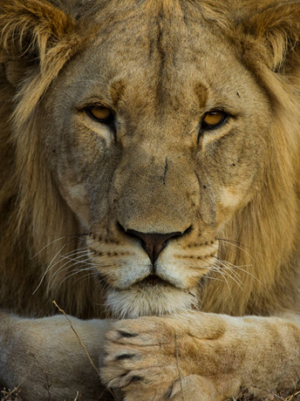News
Latest Lion Aid News
What is the value of a lion?
Friday 11th January 2013
|
3.5 MILLION DOLLAR CAT On the 10th January I attended a lecture by Tony Juniper – the title was “What has nature ever done for us?” - it covered what is these days called “ecosystem services”. Such values are very often underappreciated. Let me explain. In terms of wildlife, the eminent economist Robert Mugabe (who is also President of Zimbabwe) has been attributed saying “if it pays it stays”. The problem is that wildlife has been paying but it is not staying. And sadly, the tangible value of wildlife accumulates best in the real economy if it is dead. This means that the meat can be eaten, the horns and tusks and teeth and claws sold, the trophies and skins mounted on walls. Tony uses as one example the mangrove forests in Belize – he estimates that while these mangroves have a timber value, this is greatly exceeded by less immediately tangible “services” including $15 million per year in terms of fish yields, $150 million per year in terms of environmental contribution to tourism, and another $150 million per year in terms of storm protection from frequent hurricanes. He does not estimate the value of these forests in terms of carbon absorption. Let’s look at lions. Trophy hunters are charged anywhere between $40,000 to $120,000 for a 21-day safari to shoot one and the largest percentage of those fees accumulate to the hunting operators rather than the African lion range states. And then the lion is dead. It is a well-known fact that the reason why wildlife tourists come to Africa is to see lions (unless they are members of that unusual sect called “twitchers” who rush around the world in search of birds). Some time ago an economist placed the value of a live male lion in Amboseli at $500,000 per year in terms of tourism income to the national park. Let’s do a similar calculation. Kenya earns about $1 billion annually from tourism, and if we very conservatively estimate that about $500 million accumulates from wildlife tourism (many tourists want to spend their entire vacation sitting on beaches for reasons that puzzle me), and if we accept that Kenya has about 1,400 lions remaining, each live lion is worth $357,143 per year. That number includes cubs, subadults, males and females but is pretty close to the Amboseli figure. Conservatively assuming that a lion lives about ten years, it means each one is worth over $3.5 million. The next time you see a pride of about ten lions, what you are looking at is worth $35 million to Kenya. If we accept that Kenya has on the order of 25,000 elephants (some say 35,000 but I seriously doubt that) then each living elephant is worth about $20,000 per year by the same measure. Recently twelve elephants in one “family” were killed in Tsavo in an event that made international news. The total toll in 2012 for elephant poaching in Kenya stands at about 360. The Minister of Wildlife and Forestry seems to be taking a tough stand after the Tsavo killings and has called for more funds to assist the Kenya Wildlife Service to do a better job protecting Kenya’s wildlife resources. So he should, as 360 elephants poached means Kenya has lost animals to the value of $7.2 million, and such levels of poaching could have a significant further impact as tourists might decide to go elsewhere in Africa to do some elephant spotting. Tony Juniper and others have long urged us to look at the value of living nature. Perhaps the more they disappear the more we begin to realize that live lions are worth far more than one mounted on a wall and that decision makers will take note? Please support us to conserve the remaining fragile lion populations.Thank you. Categories: Trophy Hunting |
Posted by Pieter Kat at 17:14
No comments have been posted yet.
Add a new comment
Existing user
New user sign up




